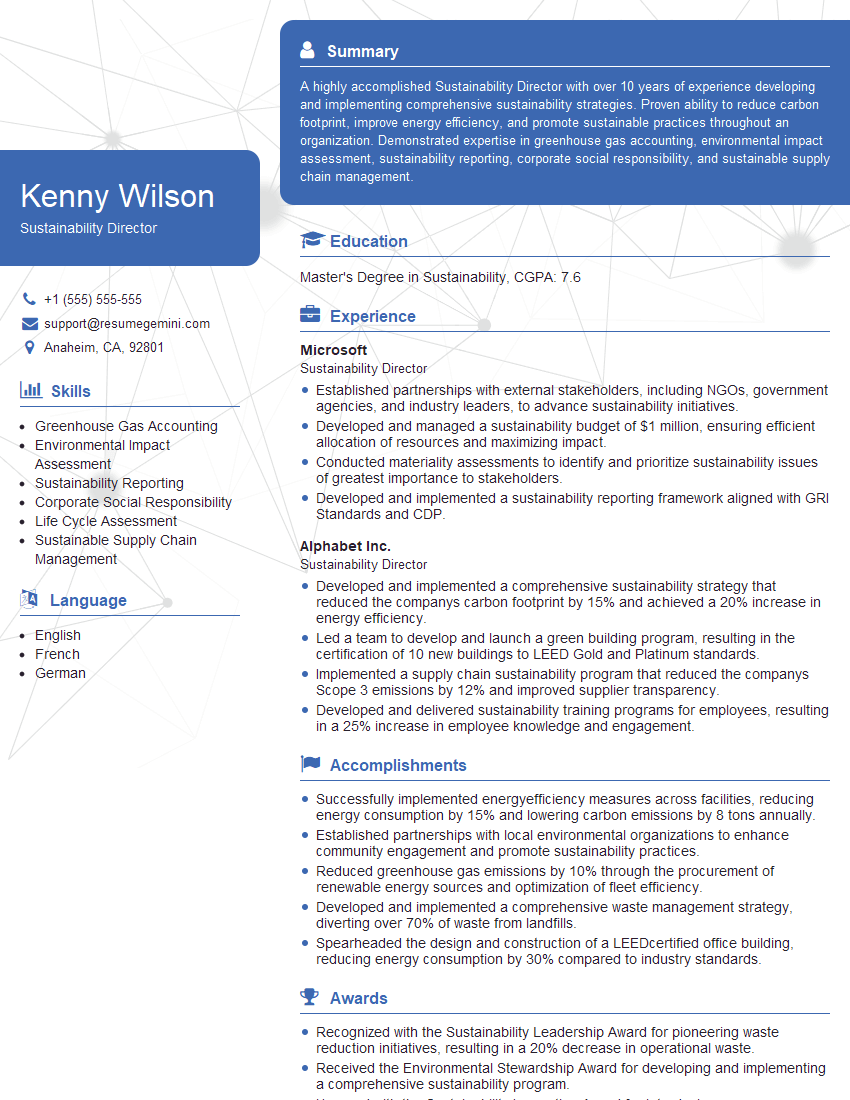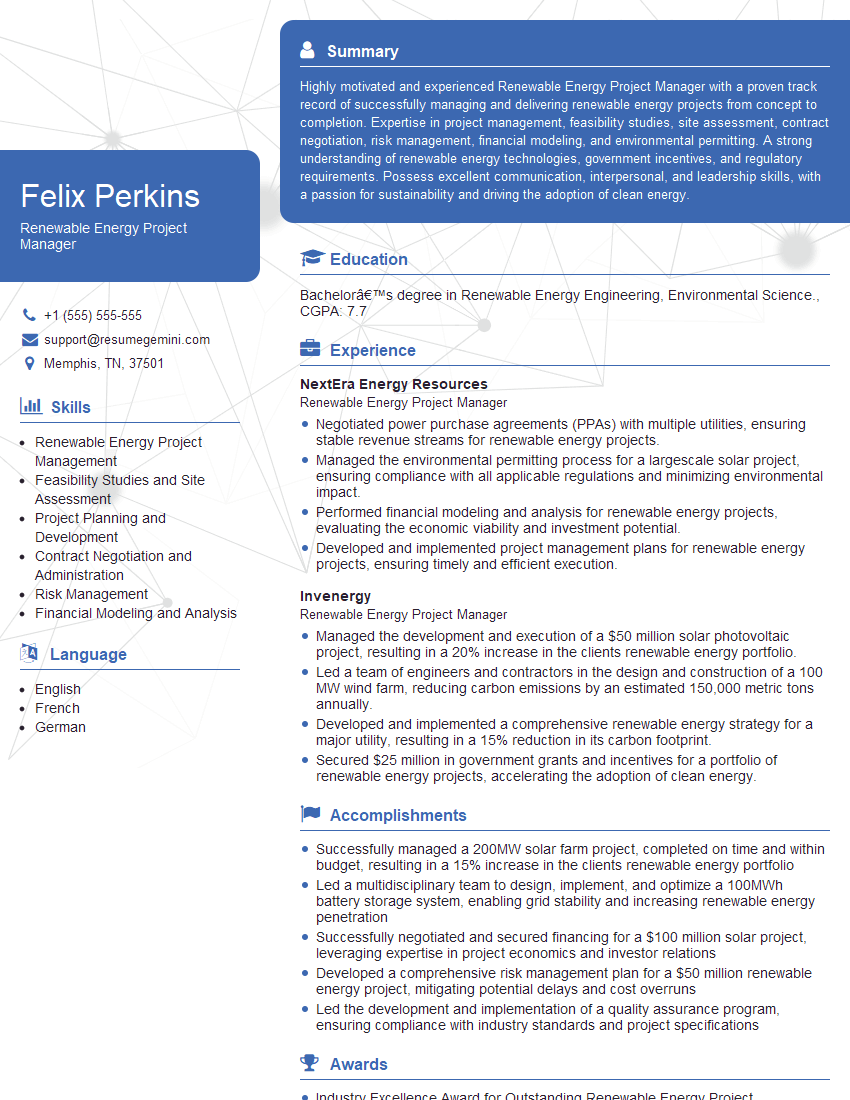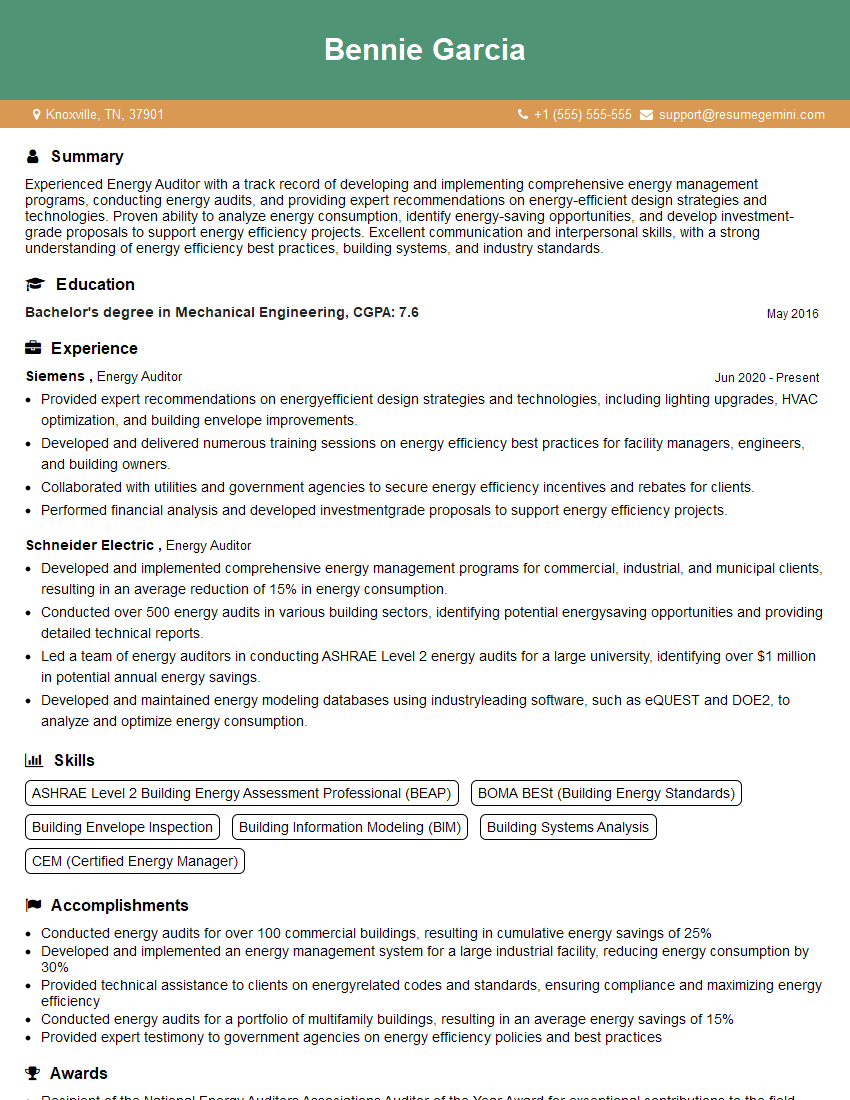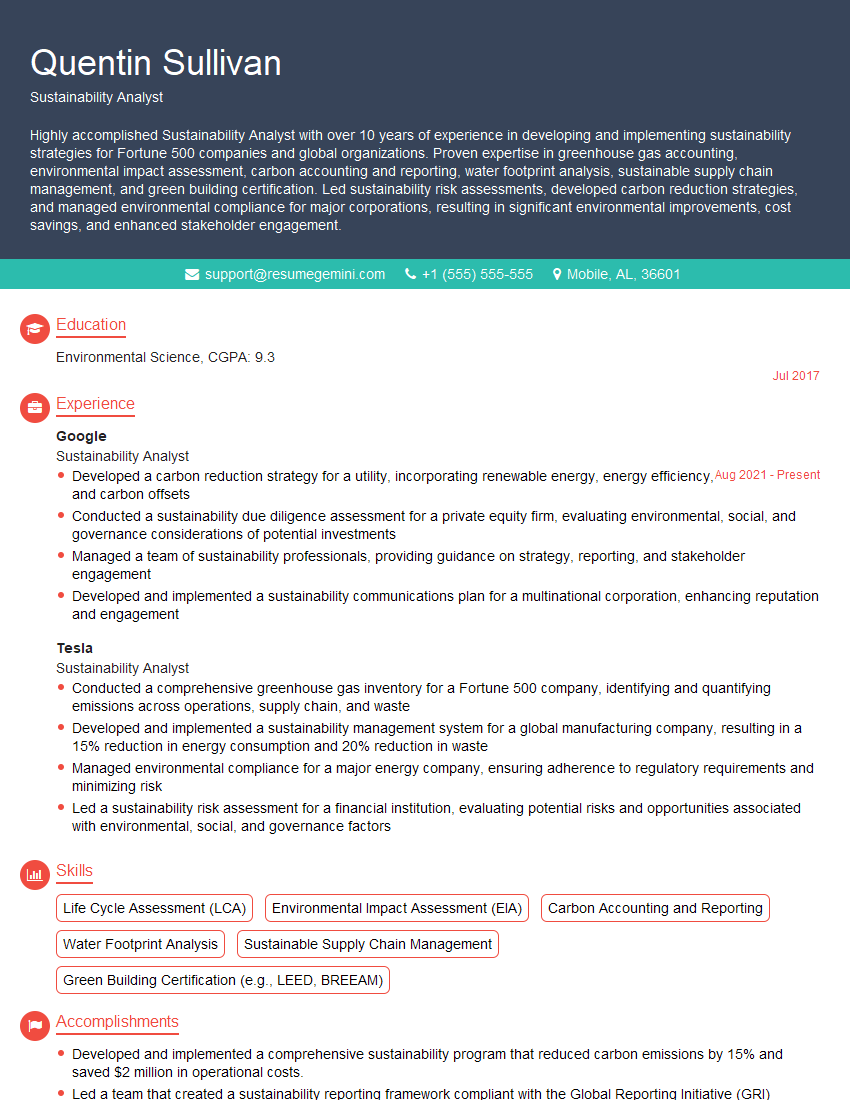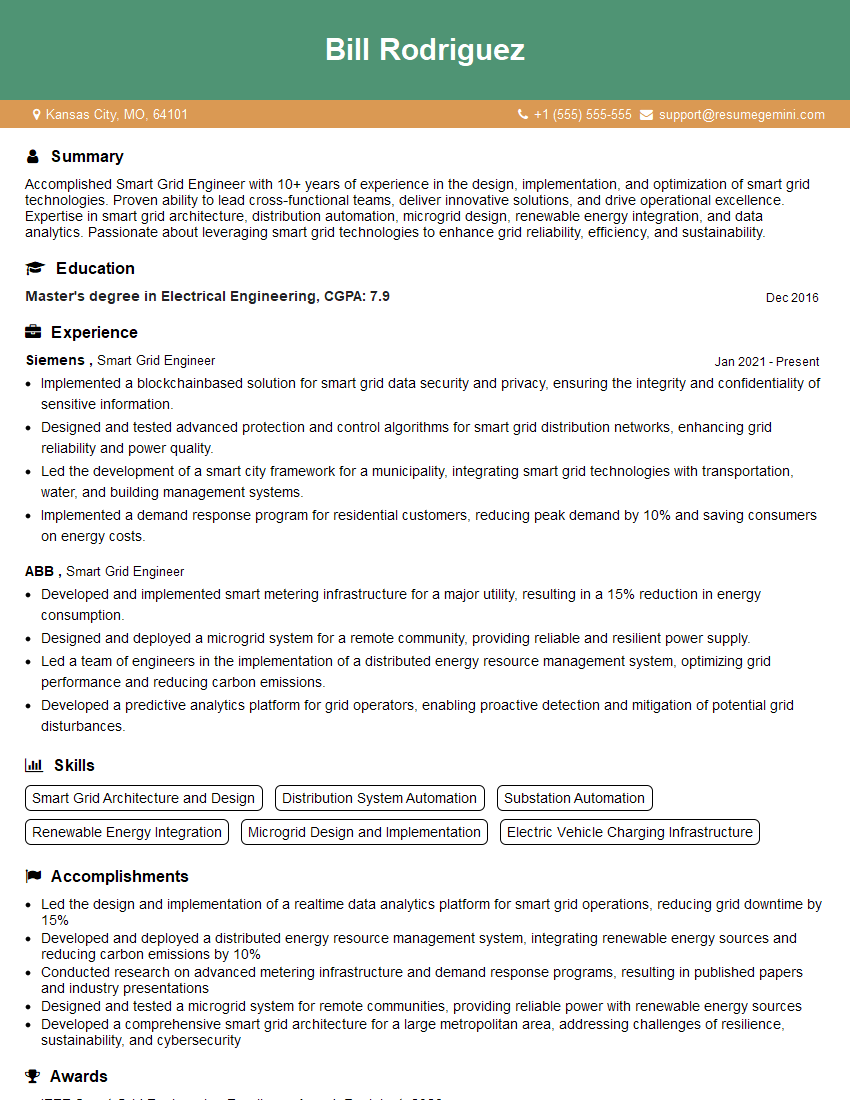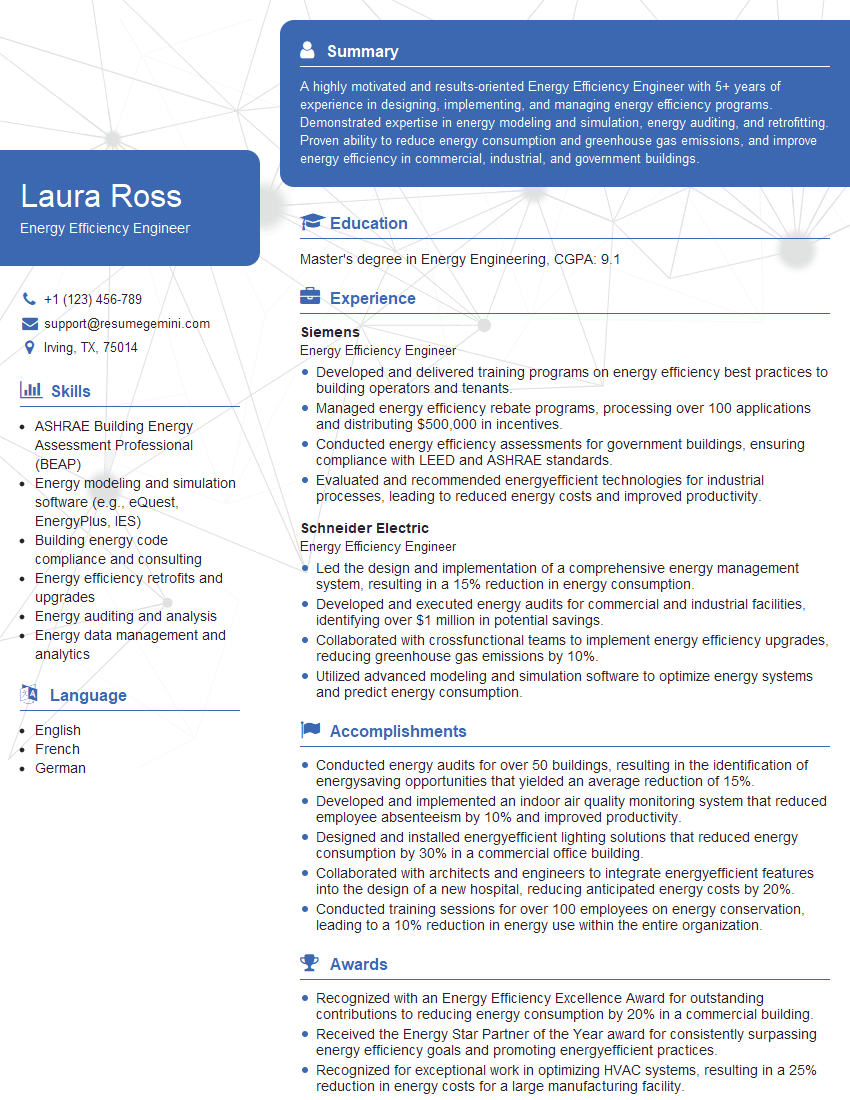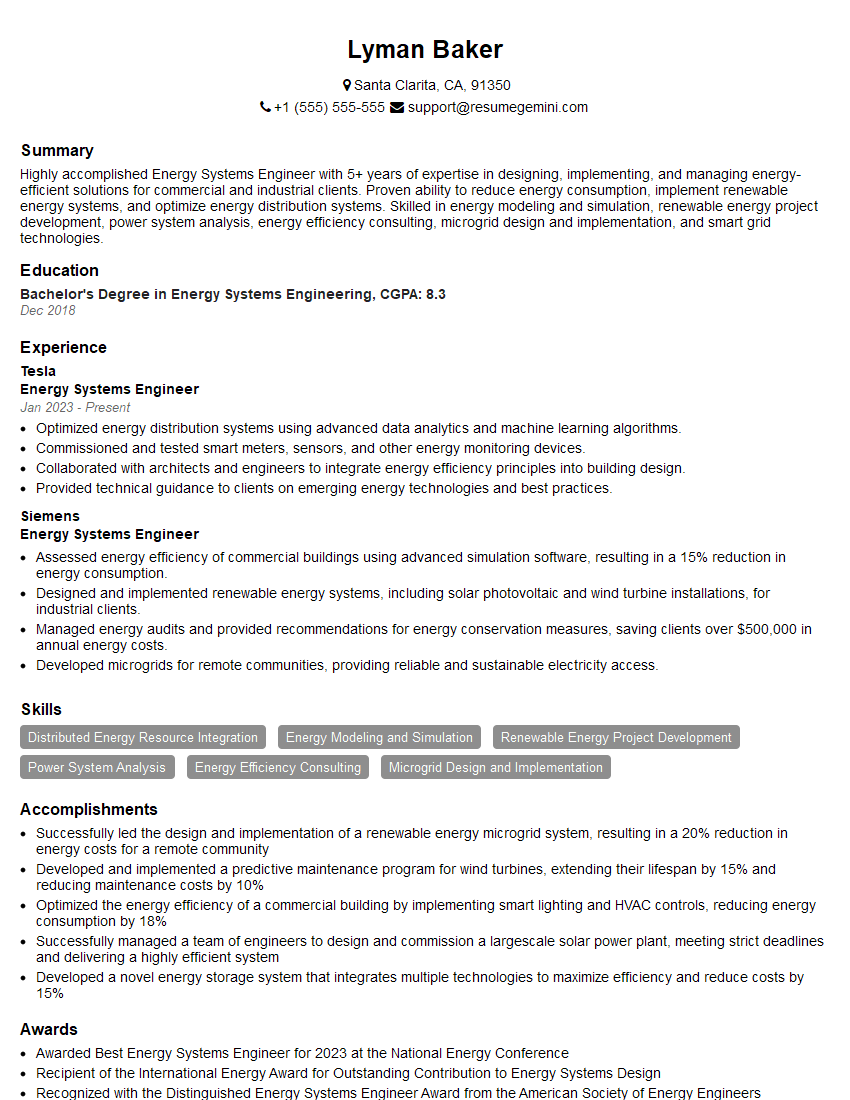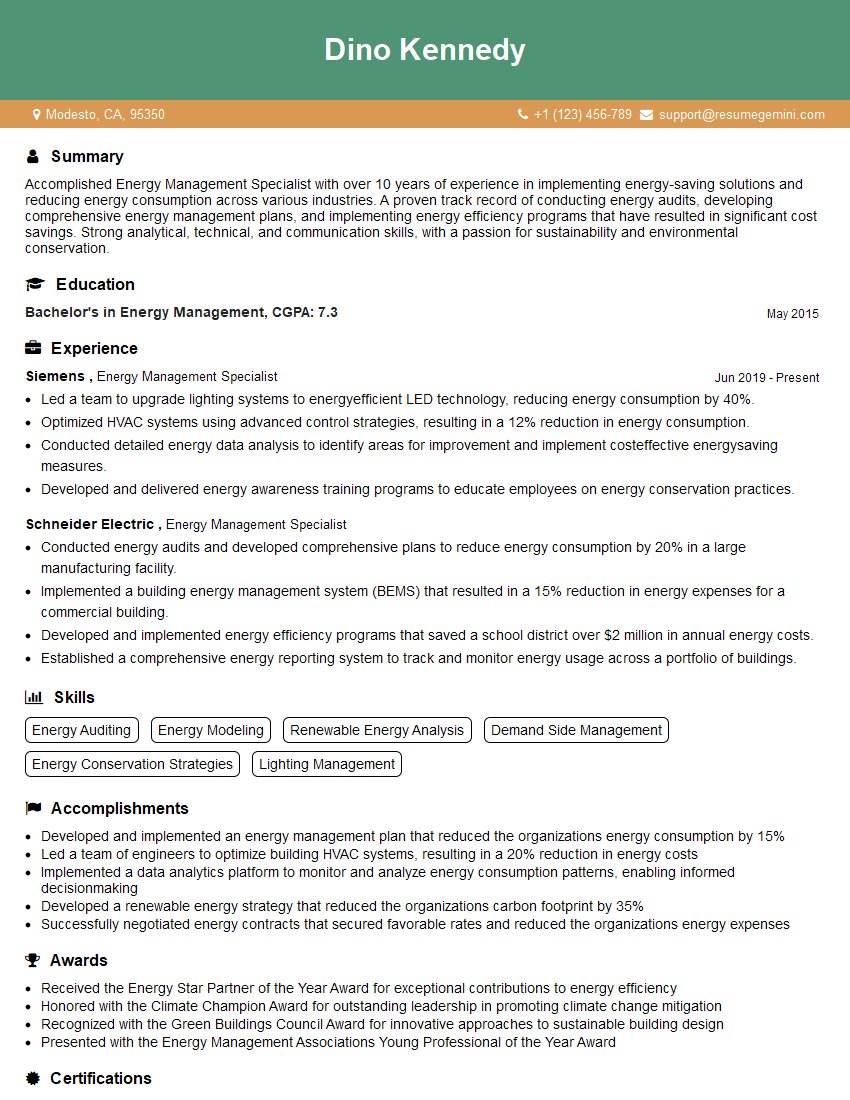Interviews are more than just a Q&A session—they’re a chance to prove your worth. This blog dives into essential Energy Sustainability Planning interview questions and expert tips to help you align your answers with what hiring managers are looking for. Start preparing to shine!
Questions Asked in Energy Sustainability Planning Interview
Q 1. Explain the concept of Life Cycle Assessment (LCA) in relation to energy projects.
Life Cycle Assessment (LCA) is a comprehensive methodology used to evaluate the environmental impacts associated with a product, process, or service throughout its entire lifespan. In the context of energy projects, this means analyzing everything from resource extraction and manufacturing of components (like solar panels or wind turbine blades) to construction, operation, maintenance, decommissioning, and eventual disposal or recycling.
Imagine building a wind farm. An LCA would consider the environmental impacts of mining the materials for the turbines, manufacturing the turbines, transporting them to the site, constructing the foundations, operating the turbines (including noise pollution and habitat impact), maintaining the turbines, and finally, decommissioning and recycling or disposing of them at the end of their operational life. This holistic approach allows for a more informed decision-making process, comparing the environmental footprint of different energy project options.
LCAs typically involve a detailed inventory analysis, impact assessment (using various metrics like global warming potential, acidification potential, etc.), and interpretation of results. Software tools are often used to streamline the process, and the results help determine the ‘best’ project option from an environmental standpoint.
Q 2. Describe different renewable energy sources and their respective pros and cons.
Renewable energy sources offer a sustainable alternative to fossil fuels. Let’s explore some key examples:
- Solar Power: Uses photovoltaic cells to convert sunlight directly into electricity. Pros: Abundant resource, decreasing costs, minimal operational emissions. Cons: Intermittency (sunlight dependence), land use requirements, manufacturing impacts.
- Wind Power: Converts wind energy into electricity using wind turbines. Pros: High energy output, relatively low environmental impact (once operational), cost reductions. Cons: Intermittency (wind dependence), visual impact on landscapes, potential impacts on wildlife (birds and bats).
- Hydropower: Generates electricity using the flow of water. Pros: Reliable energy source, long lifespan. Cons: Environmental impacts on aquatic ecosystems, high upfront capital costs, potential for greenhouse gas emissions from decaying organic matter in reservoirs.
- Geothermal Energy: Utilizes heat from the Earth’s interior. Pros: Reliable, consistent energy output, minimal emissions. Cons: Location-specific, potential for induced seismicity, high initial investment costs.
- Biomass Energy: Burns organic matter (wood, crops, etc.) to produce energy. Pros: Utilizes readily available resources, can contribute to carbon neutrality (if sustainably managed). Cons: Air pollution concerns (if not properly managed), potential deforestation, competition with food production.
Q 3. How do you calculate a carbon footprint for a building or organization?
Calculating a carbon footprint involves quantifying all greenhouse gas emissions (GHGs) directly and indirectly associated with a building or organization. This is typically expressed in tons of carbon dioxide equivalent (CO2e).
For a building, this might include:
- Direct Emissions (Scope 1): Emissions from on-site sources, such as natural gas boilers or building-owned vehicles.
- Indirect Emissions (Scope 2): Emissions from purchased electricity and heating. You’ll need energy consumption data and emission factors from the electricity provider.
- Indirect Emissions (Scope 3): These are the trickiest and represent all other indirect emissions, including embodied carbon in construction materials, transportation of materials and occupants, waste disposal, and even the products consumed within the building. This requires a more detailed inventory and often relies on estimates using databases and industry average emission factors.
For an organization, you expand on these scopes to include emissions from all operations, supply chains, and even business travel. Tools like carbon accounting software assist with data collection, calculation, and reporting. The process often involves:
- Data Gathering: Collect energy bills, material specifications, transportation data, waste data, etc.
- Emission Factor Application: Use appropriate emission factors for each source to convert energy consumption or material quantities into GHG emissions.
- Calculation and Aggregation: Sum up all emission sources to get the total carbon footprint.
- Reporting: Present the results clearly and transparently.
Accurate carbon footprint calculations are crucial for setting emission reduction targets and tracking progress towards sustainability goals.
Q 4. What are the key performance indicators (KPIs) used to measure energy sustainability success?
Key Performance Indicators (KPIs) are vital for tracking progress in energy sustainability. Examples include:
- Energy Consumption per square foot (or per unit of production): Shows improvements in energy efficiency over time.
- Greenhouse Gas (GHG) Emissions (in CO2e): Tracks the overall environmental impact of operations.
- Renewable Energy Percentage: Measures the proportion of energy from renewable sources.
- Energy Intensity (energy use per unit of output): Useful for manufacturing or industrial settings.
- Water Consumption per unit of energy produced: Relevant for water-intensive energy technologies (like hydropower).
- Waste Diversion Rate: Measures the percentage of waste diverted from landfills through recycling or composting.
- Carbon Footprint Reduction (compared to a baseline): Shows progress towards emission reduction targets.
- Employee Engagement in Sustainability Initiatives: Tracks the success of internal programs promoting sustainable behaviors.
Choosing the right KPIs depends on the specific goals and context. Regular monitoring and analysis of these KPIs are crucial for effective energy sustainability management.
Q 5. What strategies can be implemented to improve energy efficiency in a commercial building?
Improving energy efficiency in commercial buildings is crucial for reducing operational costs and environmental impact. Strategies include:
- Building Envelope Improvements: Enhance insulation, install high-performance windows, and seal air leaks to reduce heating and cooling loads.
- High-Efficiency HVAC Systems: Upgrade to modern, energy-efficient heating, ventilation, and air conditioning systems, potentially incorporating heat recovery systems.
- Lighting Upgrades: Replace conventional lighting with LED lighting, taking advantage of daylight harvesting techniques.
- Smart Building Management Systems: Implement systems that optimize energy use based on occupancy, weather conditions, and other factors. This may include smart thermostats, lighting controls, and automated HVAC systems.
- Renewable Energy Integration: Install solar panels on the roof or explore other on-site renewable energy options.
- Water Efficiency Measures: Reduce water heating energy consumption through low-flow fixtures and efficient water heating systems.
- Occupancy Sensors: Turn off lighting and equipment automatically when spaces are unoccupied.
- Energy Audits and Commissioning: Conduct regular energy audits to identify areas for improvement and commissioning to ensure systems operate optimally.
- Behavioral Changes: Educate occupants about energy conservation measures and promote responsible energy use.
A holistic approach, combining multiple strategies, often yields the greatest improvements in energy efficiency.
Q 6. Explain the role of smart grids in enhancing energy sustainability.
Smart grids play a vital role in enhancing energy sustainability by enabling more efficient and reliable delivery of electricity, particularly when integrating renewable energy sources. They utilize advanced digital technologies, such as sensors, communication networks, and data analytics to:
- Improve Grid Reliability: Real-time monitoring and control capabilities help prevent outages and ensure a more stable grid.
- Increase Renewable Energy Integration: Manage the intermittent nature of renewable energy sources (like solar and wind) by balancing supply and demand dynamically.
- Enhance Energy Efficiency: Smart meters provide consumers with real-time data about their energy use, encouraging conservation. Demand-side management programs can shift electricity consumption to off-peak hours.
- Reduce Transmission Losses: Optimize power flow and minimize energy losses during transmission and distribution.
- Enable Distributed Generation: Facilitate the integration of small-scale distributed generation sources, like rooftop solar panels, into the grid.
- Improve Grid Flexibility: Adapt to changing energy demands and support the expansion of electric vehicles and other emerging technologies.
Ultimately, smart grids contribute to a more resilient, sustainable, and efficient energy system.
Q 7. Describe your experience with energy modeling and simulation software.
I have extensive experience with various energy modeling and simulation software packages, including EnergyPlus, TRNSYS, and eQUEST. I’ve used these tools extensively to model the energy performance of buildings, districts, and even entire communities. For example, I recently used EnergyPlus to model the energy performance of a proposed zero-net-energy office building, exploring different design options to optimize energy efficiency. This involved creating detailed building models, incorporating weather data, and simulating the building’s energy consumption under various operational scenarios.
Example EnergyPlus Input: !ZoneName,NorthZone,SouthZone,...
My experience encompasses both building energy simulation and renewable energy resource assessment. I’m proficient in using software to assess the potential of solar and wind energy resources at various sites, factoring in geographic location, climate data, and terrain characteristics. This helps in determining the optimal location and size of renewable energy systems. This process invariably includes sensitivity analysis to assess the impact of different parameters on the overall results. The outputs from these models are crucial in informing design choices, optimizing system performance, and reducing project risk. I am also comfortable interpreting and communicating the findings to both technical and non-technical audiences.
Q 8. How do you identify and assess energy-saving opportunities within an organization?
Identifying energy-saving opportunities starts with a thorough understanding of an organization’s energy consumption patterns. Think of it like a detective investigating a crime scene – we need to gather evidence to pinpoint the culprits (energy waste).
- Energy Audits: We conduct detailed energy audits, which involve analyzing energy bills, site surveys, and even using specialized equipment to measure energy usage at various points. This helps us identify areas with high energy consumption and pinpoint inefficiencies.
- Data Analysis: We analyze historical energy consumption data to identify trends and anomalies. For example, a sudden spike in energy use during a specific time of day might indicate a malfunctioning piece of equipment or inefficient process.
- Operational Reviews: We observe daily operations to understand energy-intensive processes. For instance, inefficient lighting practices or improperly maintained HVAC systems can significantly impact energy consumption.
- Technology Assessment: We evaluate existing technologies and identify opportunities for upgrades. This could include upgrading to energy-efficient lighting, installing smart thermostats, or implementing building automation systems.
For example, in a manufacturing plant, an energy audit might reveal that a particular production line is consuming far more energy than expected. Further investigation might show that outdated motors are the culprit. Replacing them with high-efficiency motors becomes a clear energy-saving opportunity. The entire process is iterative. We identify opportunities, implement solutions, monitor the impact, and then re-evaluate for further improvements.
Q 9. What are your strategies for engaging stakeholders in energy sustainability initiatives?
Engaging stakeholders is crucial for the success of any energy sustainability initiative. Think of it as building a team to achieve a common goal. We use a multi-pronged approach:
- Communication: We clearly communicate the benefits of energy sustainability – not just environmental benefits, but also cost savings and improved operational efficiency. This resonates with a wider range of stakeholders.
- Incentives: We might create reward systems for employees who contribute to energy-saving efforts. This could involve things like team competitions or financial incentives.
- Collaboration: We actively involve stakeholders in the decision-making process. This includes regular updates, feedback sessions, and opportunities for input on energy-saving projects.
- Training: We provide training to employees on energy-efficient practices. This empowers them to contribute to the initiative directly.
- Transparency: We regularly report on progress and celebrate successes. Transparency builds trust and reinforces the value of the program.
For instance, in a large office building, we might involve building managers, maintenance staff, and even individual tenants in identifying energy-saving opportunities. This participatory approach fosters ownership and increases the likelihood of successful implementation.
Q 10. Explain different energy audit methodologies.
Energy audit methodologies vary depending on the scope and objectives of the audit. However, common methodologies include:
- Walk-through Audits: These are quick, preliminary assessments conducted by visual inspection, reviewing energy bills, and asking operational personnel about practices. It’s like a quick health check.
- Level 1 Audits: These involve detailed analysis of energy bills and site records, including equipment inventories and operational data. This is a deeper dive.
- Level 2 Audits: These include Level 1 activities, plus on-site measurements of energy consumption using instruments like power meters and thermal imaging cameras to pinpoint problem areas. This involves more hands-on investigation.
- Level 3 Audits: These are the most comprehensive, incorporating detailed energy modeling and simulations to predict the impact of proposed energy efficiency measures. This is an advanced analysis using predictive modelling.
The choice of methodology depends on the organization’s budget, time constraints, and the complexity of its energy systems. A walk-through might suffice for a small business, while a Level 3 audit would be more suitable for a large industrial facility.
Q 11. How do you measure and report on greenhouse gas emissions?
Measuring and reporting greenhouse gas (GHG) emissions involves a systematic approach. First, we identify all sources of emissions within the organization’s operations, including energy consumption from electricity, heating, transportation, and waste generation.
We then use established methodologies like the Greenhouse Gas Protocol to calculate emissions. This involves applying emission factors specific to energy sources and activities. For example, the emission factor for electricity generated from coal will be different from that of electricity generated from solar power. We also take into account any carbon offsets.
The data is typically reported using standardized frameworks such as the Carbon Disclosure Project (CDP) reporting framework. Reporting transparency and accuracy is paramount to ensure credibility. The final report clearly outlines the methodologies used, data sources, and any assumptions made. This allows for verification and comparison with other organizations.
Q 12. What are your experience with renewable energy project development?
My experience with renewable energy project development encompasses various stages, from feasibility studies and permitting to construction and commissioning. I have worked on projects ranging from rooftop solar installations for commercial buildings to large-scale wind farms.
For instance, I recently led a project to develop a 5 MW solar farm for a regional utility. This involved securing land rights, obtaining necessary permits, managing contractors, and overseeing construction. We had to consider factors such as solar irradiance, grid connection capacity, and environmental impact assessment. Each project presents unique challenges, which is what makes it both fascinating and rewarding.
My expertise also includes evaluating the financial viability of renewable energy projects, identifying suitable financing options, and assessing the long-term operational and maintenance requirements.
Q 13. What are the key regulatory and policy considerations related to renewable energy projects?
Key regulatory and policy considerations for renewable energy projects vary considerably by location. However, some common aspects include:
- Permitting and Licensing: Obtaining the necessary permits and licenses from local, regional, and national authorities. This can be a complex and time-consuming process.
- Grid Connection: Securing grid connection agreements with the utility company to ensure the generated renewable energy can be fed into the power grid. This often involves substantial technical and contractual negotiations.
- Environmental Regulations: Complying with environmental regulations regarding land use, wildlife protection, and water resources. This could require environmental impact assessments and mitigation plans.
- Financial Incentives: Taking advantage of any available financial incentives, such as tax credits, subsidies, or renewable energy certificates (RECs).
- Land Use Regulations: Navigating land use regulations related to zoning, building codes, and other relevant regulations.
Understanding the specific regulatory landscape of a project’s location is critical for success. Non-compliance can lead to delays, cost overruns, and even project termination. Therefore, we always engage legal and regulatory experts to guide us through this process. Each project must be carefully tailored to its legal and policy constraints.
Q 14. How do you manage energy procurement to ensure sustainability?
Managing energy procurement sustainably focuses on sourcing energy from renewable sources and prioritizing energy efficiency. Think of it as choosing your groceries wisely: you select healthy, ethically sourced options rather than relying on less sustainable choices.
- Renewable Energy Contracts: We negotiate power purchase agreements (PPAs) with renewable energy generators, such as wind or solar farms. This ensures a steady supply of renewable energy to the organization.
- Energy Efficiency Programs: We actively participate in energy efficiency programs offered by utilities and other organizations. This can provide incentives and support for energy-saving initiatives.
- Green Tariffs: We explore options like green tariffs offered by electricity providers. These tariffs allow us to purchase electricity generated from renewable sources.
- Demand-Side Management: We implement demand-side management strategies to reduce peak demand and optimize energy consumption patterns.
- Carbon Offsetting: We might use carbon offsets to neutralize any remaining emissions that cannot be reduced through other means.
For example, a large corporation might enter into a PPA with a solar farm to meet a portion of its electricity needs. This reduces its reliance on fossil fuel-based electricity and lowers its carbon footprint.
Q 15. How do you assess the financial viability of energy efficiency projects?
Assessing the financial viability of energy efficiency projects requires a thorough cost-benefit analysis. We need to carefully weigh the upfront investment costs against the long-term savings in energy consumption. This involves several key steps:
- Estimating energy savings: This relies on detailed energy audits, using software and modelling to project reductions in energy use after implementing efficiency measures (e.g., LED lighting, improved insulation).
- Calculating payback period: This determines how long it takes for the cumulative energy savings to cover the initial investment. A shorter payback period indicates better financial viability.
- Determining Net Present Value (NPV): NPV considers the time value of money, discounting future savings to their present value. A positive NPV suggests the project is financially worthwhile.
- Internal Rate of Return (IRR): IRR represents the discount rate that makes the NPV of the project equal to zero. A higher IRR indicates a more attractive investment.
- Considering financing options: Securing funding through grants, loans, or energy performance contracts can significantly influence the project’s financial feasibility. We explore all available options.
For example, in a recent project for a school district, we used sophisticated building energy modeling to predict the energy savings from a large-scale LED lighting upgrade. By comparing this projected savings to the upfront investment and considering available grants, we demonstrated a very attractive payback period of less than three years, making the project highly viable.
Career Expert Tips:
- Ace those interviews! Prepare effectively by reviewing the Top 50 Most Common Interview Questions on ResumeGemini.
- Navigate your job search with confidence! Explore a wide range of Career Tips on ResumeGemini. Learn about common challenges and recommendations to overcome them.
- Craft the perfect resume! Master the Art of Resume Writing with ResumeGemini’s guide. Showcase your unique qualifications and achievements effectively.
- Don’t miss out on holiday savings! Build your dream resume with ResumeGemini’s ATS optimized templates.
Q 16. What are your experience with ESG reporting frameworks (GRI, SASB, TCFD)?
I have extensive experience with ESG (Environmental, Social, and Governance) reporting frameworks, particularly GRI (Global Reporting Initiative), SASB (Sustainability Accounting Standards Board), and TCFD (Task Force on Climate-related Financial Disclosures). My work involves translating complex sustainability data into clear, concise reports that align with these frameworks.
- GRI: I utilize the GRI Standards to provide comprehensive, stakeholder-focused reporting, covering environmental, social, and economic performance indicators. This includes metrics on energy consumption, greenhouse gas emissions, water usage, and waste management.
- SASB: I leverage SASB standards to focus on material sustainability issues relevant to specific industries, ensuring the reports are tailored to investor needs and address the most impactful environmental and social aspects.
- TCFD: I incorporate TCFD recommendations to assess and disclose climate-related risks and opportunities, including scenario planning and governance structures for managing climate change impacts.
In a recent project for a large manufacturing company, we developed a comprehensive ESG report aligned with GRI, SASB, and TCFD requirements. This report not only enhanced the company’s transparency but also attracted investors seeking sustainable and responsible businesses.
Q 17. Explain your understanding of net-zero energy building concepts.
A net-zero energy building produces as much renewable energy as it consumes over a year. It’s a highly ambitious but increasingly achievable goal. Achieving net-zero status requires a holistic approach that integrates several key elements:
- Highly efficient building envelope: This involves superior insulation, airtight construction, and high-performance windows to minimize energy losses.
- Renewable energy generation: On-site renewable energy sources, such as solar photovoltaic (PV) panels or small wind turbines, are crucial for generating the energy needed to offset consumption.
- Energy-efficient systems: High-efficiency HVAC (Heating, Ventilation, and Air Conditioning) systems, lighting, and appliances are essential for minimizing energy use.
- Smart building technologies: Building automation systems and smart sensors optimize energy use in real-time, improving overall efficiency.
Imagine a hospital designed with net-zero in mind. It would incorporate solar panels on the roof, highly efficient HVAC systems controlled by a smart building management system, and LED lighting throughout. This reduces the hospital’s carbon footprint significantly and improves its long-term financial sustainability.
Q 18. What are your strategies for reducing water consumption in buildings?
Reducing water consumption in buildings requires a multi-pronged approach focusing on both indoor and outdoor water use. My strategies include:
- Installing low-flow fixtures: Replacing traditional faucets, showerheads, and toilets with low-flow models drastically reduces water usage without compromising functionality.
- Implementing water-efficient landscaping: Choosing drought-tolerant plants and using efficient irrigation systems, such as drip irrigation, minimizes outdoor water consumption.
- Leak detection and repair: Regularly inspecting plumbing systems and promptly repairing any leaks can prevent significant water waste.
- Water harvesting and reuse: Collecting rainwater for irrigation or non-potable uses (e.g., toilet flushing) can significantly reduce reliance on municipal water supplies.
- Smart irrigation systems: Using weather-based controllers and soil moisture sensors optimizes irrigation scheduling, minimizing unnecessary water use.
For example, in a recent office building renovation, we implemented low-flow fixtures and a rainwater harvesting system for irrigation, resulting in a 40% reduction in overall water consumption.
Q 19. What is your approach to integrating sustainability into the design and construction phases of a project?
Integrating sustainability into the design and construction phases requires a proactive and collaborative approach. This starts from the very beginning of a project and includes:
- Sustainable site selection: Choosing a site that minimizes environmental impact, utilizes existing infrastructure, and promotes access to public transport.
- Sustainable material selection: Prioritizing recycled, renewable, and locally sourced materials to reduce embodied carbon and transportation emissions.
- Construction waste management: Implementing efficient waste management strategies to minimize landfill waste and maximize recycling and reuse.
- LEED (Leadership in Energy and Environmental Design) certification: Pursuing LEED certification provides a framework for integrating sustainability principles throughout the project lifecycle and provides third-party verification.
- Lifecycle assessment: Evaluating the environmental impact of materials and construction methods throughout the entire lifecycle of the building.
In a recent residential development, we worked with the architect and builder to select sustainable materials, implement efficient construction waste management practices, and ensure the project met LEED standards. This approach not only enhanced the project’s environmental performance but also reduced its overall cost in the long term.
Q 20. Describe your experience with energy management systems (EMS).
Energy Management Systems (EMS) are crucial for optimizing building energy performance. My experience encompasses the design, implementation, and ongoing management of EMS in various building types. These systems typically include:
- Building automation systems (BAS): Centralized control systems that monitor and control HVAC, lighting, and other building systems.
- Data acquisition and monitoring: Real-time data collection on energy consumption, allowing for identification of inefficiencies and optimization opportunities.
- Energy modeling and forecasting: Predictive modeling to anticipate energy needs and proactively adjust building systems.
- Alarm and alert systems: Notifications for equipment malfunctions or energy consumption anomalies.
- Reporting and analytics: Detailed reports on energy use, allowing for data-driven decision-making and continuous improvement.
I’ve used EMS to identify and rectify hidden energy waste in numerous buildings. For instance, in one project, an EMS revealed that a malfunctioning chiller was consuming excessive energy. By identifying and fixing this problem, we achieved significant energy savings.
Q 21. How do you assess the risk associated with renewable energy projects?
Assessing the risk associated with renewable energy projects requires a comprehensive approach. Risks can be categorized into:
- Technical risks: These relate to the reliability and performance of the renewable energy technology. Factors like equipment failure, intermittency (e.g., solar power dependent on sunlight), and grid integration challenges need thorough evaluation.
- Financial risks: This encompasses the initial investment cost, financing availability, fluctuating energy prices, and potential revenue shortfalls.
- Regulatory risks: Changes in government policies, permitting processes, and feed-in tariffs can impact project viability.
- Environmental risks: Concerns about land use, visual impact, habitat disruption, and potential negative effects on the environment need to be addressed and mitigated.
- Social risks: Public acceptance, community engagement, and potential conflicts with local stakeholders can impact project success.
For example, when evaluating a wind farm project, we would conduct thorough site assessments to consider wind resource availability, assess grid connection capacity, and engage with local communities to address potential concerns. By systematically identifying and mitigating these risks, we enhance the project’s chances of success.
Q 22. How do you prioritize energy saving measures based on their cost-effectiveness?
Prioritizing energy-saving measures based on cost-effectiveness involves a systematic approach that balances upfront investment with long-term savings. We use a technique called Life-Cycle Cost Analysis (LCCA). This method compares the total cost of ownership for different options over their entire lifespan, not just the initial purchase price.
Here’s a step-by-step process:
- Identify Potential Measures: Begin by compiling a list of all feasible energy-saving measures, such as LED lighting upgrades, improved insulation, HVAC system optimization, or renewable energy integration.
- Gather Data: Collect data on the initial cost, installation cost, energy savings (kWh or therms), energy prices, maintenance costs, and the lifespan of each measure.
- Calculate LCCA: For each measure, calculate the present value of all costs (initial, installation, maintenance, etc.) and the present value of energy savings over the lifespan. The difference represents the net present value (NPV). A positive NPV indicates a cost-effective investment.
- Prioritize: Rank the measures based on their NPV, prioritizing those with the highest positive NPV. This ensures you focus on measures offering the greatest return on investment.
- Sensitivity Analysis: Conduct a sensitivity analysis to assess how changes in energy prices or other factors might affect the ranking. This helps to make robust decisions despite uncertainty.
Example: Let’s say we’re comparing LED lighting upgrades versus installing solar panels. While solar panels might have a higher upfront cost, their long-term energy savings and potential for feed-in tariffs could lead to a higher NPV over their 25-year lifespan, making them a more cost-effective choice in the long run.
Q 23. Explain different energy storage technologies and their applications.
Energy storage technologies are crucial for managing the intermittency of renewable energy sources and improving grid stability. Several technologies exist, each with its own strengths and weaknesses:
- Batteries: These are the most widely used, ranging from small-scale lithium-ion batteries for homes to large-scale flow batteries for grid applications. Lithium-ion batteries offer high energy density and relatively fast charge/discharge rates, but they have a limited lifespan and environmental concerns related to their production and disposal.
- Pumped Hydro Storage: This involves pumping water uphill to a reservoir during periods of low energy demand and releasing it to generate electricity during peak demand. It’s a mature, reliable technology, but it has significant geographical limitations and requires large amounts of land and water.
- Compressed Air Energy Storage (CAES): This technology compresses air into underground caverns or tanks during off-peak hours and releases it to drive turbines during peak demand. It offers a longer lifespan than batteries but has lower energy efficiency.
- Thermal Energy Storage: This involves storing energy as heat or cold, often using materials like molten salts or ice. It’s suitable for applications like district heating and cooling.
- Flywheels: These use rotating mechanical energy to store energy. They offer fast response times but have relatively low energy density.
Applications: Energy storage technologies find applications in various sectors:
- Grid-scale energy storage: Balancing supply and demand on the electrical grid, integrating renewable energy sources.
- Residential energy storage: Reducing reliance on the grid, improving energy independence and potentially lowering electricity bills.
- Transportation: powering electric vehicles.
- Industrial processes: providing backup power or smoothing out energy consumption.
Q 24. What is your experience with building codes and standards related to energy efficiency?
My experience with building codes and standards related to energy efficiency is extensive. I’ve worked directly with codes like ASHRAE 90.1, IECC, and local building codes in various jurisdictions. I understand the intricacies of energy modeling software (e.g., EnergyPlus) and how it’s used to demonstrate compliance. I’m familiar with the requirements for energy audits, commissioning, and ongoing energy performance monitoring. I’ve been involved in projects where we’ve had to navigate the complexities of code interpretations and exemptions, ensuring that projects meet both the letter and the spirit of the regulations.
For example, in a recent project involving a large commercial building, we leveraged ASHRAE 90.1 to design an energy-efficient HVAC system. We used EnergyPlus simulations to demonstrate compliance with the code’s requirements for energy use intensity (EUI). This not only ensured the building met the regulatory standards but also optimized its energy performance, minimizing operational costs for the client.
Q 25. How would you address resistance to change within an organization when implementing energy sustainability measures?
Addressing resistance to change when implementing energy sustainability measures requires a multifaceted approach that combines education, engagement, and clear communication.
Here’s a strategic framework:
- Build a Business Case: Clearly articulate the financial benefits (reduced energy costs, potential incentives) and environmental benefits (reduced carbon footprint, improved sustainability profile) of the proposed measures. Quantify the ROI and present it in a way that resonates with stakeholders.
- Engage Stakeholders Early: Involve all relevant stakeholders from the outset, including employees, management, and even external partners. Active participation increases buy-in and reduces resistance.
- Address Concerns Directly: Actively identify and address concerns and anxieties. This might include offering training, providing clear explanations of the changes, and demonstrating the safety and reliability of the new technologies.
- Pilot Programs: Start with a pilot program on a smaller scale to demonstrate the effectiveness of the measures before full-scale implementation. This allows for adjustments and reduces the perceived risk.
- Incentivize Participation: Offer incentives or rewards for participation and adoption of energy-saving practices. This could include recognition programs, financial incentives, or even contests.
- Celebrate Successes: Publicly acknowledge and celebrate successes throughout the implementation process. This helps to build momentum and encourage continued adoption.
Example: In one project, we encountered resistance to switching from traditional lighting to LEDs due to concerns about light quality and the upfront cost. We addressed this by conducting a demonstration, showcasing the improved light quality and highlighting the long-term cost savings. We also secured a grant that partially covered the upfront costs, further easing concerns.
Q 26. Describe your experience using data analytics to inform energy sustainability strategies.
Data analytics plays a critical role in informing energy sustainability strategies. I have extensive experience using data to identify energy waste, track progress, and optimize energy performance. This involves leveraging various data sources, including building management systems (BMS), smart meters, and energy audit reports.
Here’s how I use data analytics:
- Energy Consumption Monitoring: I regularly analyze energy consumption patterns to identify areas of high energy use and potential inefficiencies. This includes using visualization tools and statistical methods to identify trends and anomalies.
- Benchmarking: I benchmark building energy performance against similar buildings or industry standards to identify areas for improvement and measure progress.
- Predictive Modeling: I use predictive modeling techniques to forecast energy consumption based on various factors like weather patterns and occupancy levels. This helps in proactive energy management and resource planning.
- Performance Evaluation: After implementing energy-saving measures, I track the changes in energy consumption to assess the effectiveness of the interventions and make adjustments as needed.
Example: In one case, analyzing BMS data revealed that a significant portion of energy was being wasted due to inefficient HVAC operation during off-peak hours. Using predictive modeling, we optimized the HVAC scheduling, resulting in a substantial reduction in energy consumption without compromising comfort levels.
Q 27. What are your understanding of circular economy principles and their relevance to energy sustainability?
Circular economy principles are fundamentally relevant to energy sustainability. The circular economy emphasizes reducing waste and maximizing resource utilization, which directly translates to lower energy consumption and reduced environmental impact.
Here’s how circular economy principles apply to energy sustainability:
- Energy Efficiency: Designing products and processes to minimize energy consumption throughout their lifecycle, from manufacturing to disposal.
- Renewable Energy Sources: Transitioning from finite fossil fuels to renewable energy sources like solar, wind, and hydropower. This reduces reliance on resource extraction and minimizes environmental damage.
- Waste-to-Energy: Utilizing waste materials as a source of energy, such as through biomass gasification or anaerobic digestion. This reduces waste disposal needs and generates renewable energy.
- Material Recycling and Reuse: Recycling and reusing materials used in energy production and consumption, thereby reducing the demand for new resources and associated energy inputs.
- Product Lifecycle Management: Designing products for durability, repairability, and recyclability to extend their lifespan and minimize waste.
Example: Implementing a program to recycle and reuse batteries from electric vehicles is a prime example of applying circular economy principles to energy sustainability. By recovering valuable materials from spent batteries, we reduce the need for mining new materials, lowering energy consumption associated with extraction and minimizing the environmental impacts of battery production.
Key Topics to Learn for Energy Sustainability Planning Interview
- Energy Audits & Assessments: Understanding methodologies for conducting energy audits, analyzing energy consumption patterns, and identifying areas for improvement. Practical application: Developing energy efficiency recommendations for a commercial building.
- Renewable Energy Technologies: Knowledge of various renewable energy sources (solar, wind, hydro, geothermal, biomass) including their technological aspects, economic viability, and environmental impact. Practical application: Evaluating the feasibility of a solar PV system for a residential community.
- Energy Modeling & Simulation: Proficiency in using energy modeling software to predict energy performance, optimize energy systems, and assess the impact of different scenarios. Practical application: Simulating the effect of energy efficiency measures on a city’s carbon footprint.
- Policy & Regulation: Familiarity with relevant energy policies, regulations, and incentives at local, national, and international levels. Practical application: Analyzing the impact of carbon pricing mechanisms on energy investment decisions.
- Life Cycle Assessment (LCA): Understanding the principles of LCA and its application to evaluating the environmental impact of energy projects and technologies throughout their entire lifecycle. Practical application: Comparing the environmental impacts of different energy generation options.
- Sustainable Transportation Planning: Knowledge of strategies for reducing transportation’s energy consumption and emissions, including electric vehicle adoption, public transit improvements, and active transportation initiatives. Practical application: Developing a sustainable transportation plan for a university campus.
- Data Analysis & Reporting: Ability to collect, analyze, and interpret energy data to identify trends, measure progress, and report on sustainability performance. Practical application: Creating compelling visualizations to communicate energy savings and emission reductions.
Next Steps
Mastering Energy Sustainability Planning is crucial for a rewarding and impactful career. This field offers exciting opportunities to contribute to a greener future and make a real difference. To maximize your job prospects, it’s essential to create an ATS-friendly resume that highlights your skills and experience effectively. ResumeGemini can help you build a professional and compelling resume that stands out from the competition. ResumeGemini provides examples of resumes tailored to Energy Sustainability Planning, ensuring your application showcases your qualifications in the best possible light. Take advantage of this valuable resource and elevate your job search today!
Explore more articles
Users Rating of Our Blogs
Share Your Experience
We value your feedback! Please rate our content and share your thoughts (optional).
What Readers Say About Our Blog
Hi, I represent an SEO company that specialises in getting you AI citations and higher rankings on Google. I’d like to offer you a 100% free SEO audit for your website. Would you be interested?
good
